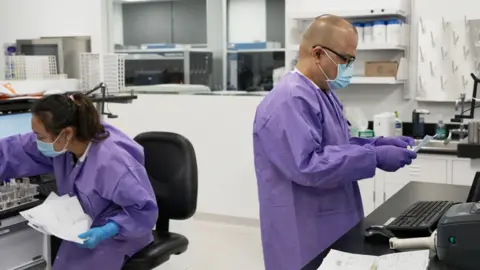AI is trained to recognize warning signs in blood tests
 getty images
getty imagesThis is the third feature in a six-part series looking at how AI is changing medical research and treatment.
Ovarian cancer is “rare, underfunded and deadly”, says Audra Moran, head of the Ovarian Cancer Research Alliance (OCRA), a New York-based global charity.
Like all cancers, the earlier it is detected the better.
Most ovarian cancer starts in the fallopian tubes, so by the time it reaches the ovaries, it has spread elsewhere.
“You may have to detect ovarian cancer five years before any symptoms appear to have an impact on mortality,” says Ms Moran.
But new blood tests are emerging that use the power of artificial intelligence (AI) to detect signs of cancer in its early stages.
And it’s not just cancer, AI can also speed up other blood tests for potentially deadly infections like pneumonia.
 Memorial Sloan Kettering Cancer Center
Memorial Sloan Kettering Cancer CenterDr. Daniel Heller is a biomedical engineer at Memorial Sloan Kettering Cancer Center in New York.
His team has developed a testing technique that uses nanotubes – tiny tubes of carbon that are about 50,000 times smaller than the diameter of a human hair.
About 20 years ago, scientists began exploring nanotubes that could emit fluorescent light.
Over the past decade, researchers learned how to change the properties of these nanotubes so that they respond to almost anything in the blood.
It’s now possible to insert millions of nanotubes into a blood sample and have them emit different wavelengths of light depending on what’s stuck to them.
But there still remains the question of interpreting the signal, which Dr. Heller compares to finding a match for a fingerprint.
The fingerprint in this case is a pattern of molecules binding to the sensor, with different sensitivities and binding strengths.
But the patterns are too subtle for humans to recognize.
“We can look at the data and not make sense of it,” he says. “We can only see patterns that are different with AI.”
Decoding the nanotube data means loading the data into a machine-learning algorithm, and telling the algorithm which samples came from patients with ovarian cancer, and which from people without cancer.
These included blood from people with other types of cancer, or other gynecological disease, which could be confused with ovarian cancer.

- More AI and Medicine
A major challenge in using AI to develop a blood test for ovarian cancer research is that it is relatively scarce, which limits the data for training algorithms.
And even much of that data is hidden within the hospitals where they are treated, with minimal data shared with researchers.
Dr. Heller describes training the algorithm on the available data of a few 100 patients as a “Hail Mary pass.”
But he says the AI was able to achieve better accuracy than the best cancer biomarkers available today – and that was just the first attempt.
Further study on the system is underway to see if it can be improved using a larger set of sensors and many more patient samples. More data can improve algorithms, just as algorithms for self-driving cars can improve with more testing on the road.
Dr. Heller has high hopes for the technology.
“What we want to do is test all gynecological diseases – so when someone comes in with a complaint, can we give doctors a tool that will tell them immediately whether it’s more likely to be cancer or not? Or worse, it’s cancer.”
Dr. Heller says this could take “three to five years.”
 Carius
CariusOne challenge is that researchers do not currently understand all the connections that an AI test can make between biomarkers and diseases.
Over the past two years Dr. Slavey Petrovsky has developed an AI platform called Milton, which identifies 120 diseases with a success rate of over 90% using biomarkers in UK Biobank data.
Finding patterns in data on such a large scale can only be done by AI.
“These are often complex patterns, where there may not be one biomarker, but you have to take into account the whole pattern,” says Dr. Petrovsky, a researcher at pharmaceutical giant AstraZeneca.
Dr. Heller uses a similar pattern matching technique in his work on ovarian cancer.
“We know that the sensor binds and reacts to proteins and small molecules in the blood, but we don’t know which proteins or molecules are specific to cancer,” he says.
More broadly, data, or the lack of it, is still a drawback.
“People aren’t sharing their data, or there’s no mechanism in place to do so,” says Ms Moran.
Ocra is funding a large-scale patient registry, containing electronic medical records of patients, that has allowed researchers to train algorithms on their data.
“It’s early days – we’re still in the Wild West of AI,” says Ms Moran.



